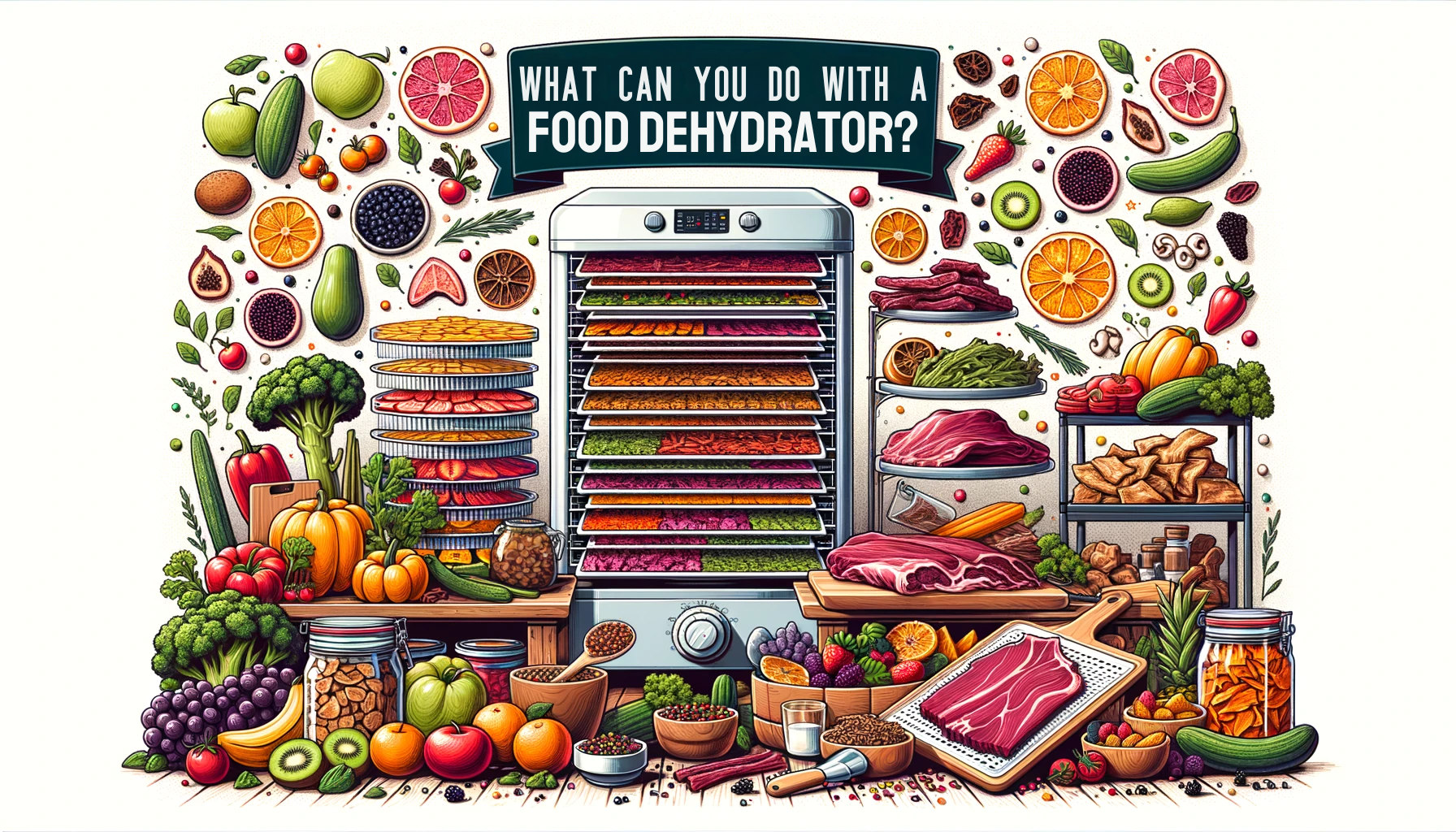Are you curious to know if food dehydrators are energy efficient? In this article, we will explore the energy efficiency of food dehydrators and provide you with some insights. Whether you are looking to preserve fruits, vegetables, or make your own beef jerky, understanding the energy consumption of food dehydrators is essential. Let’s delve into the world of food dehydrators and find out if they are a sustainable option for your kitchen.
1. Understanding Food Dehydrators
1.1 How do food dehydrators work?
Food dehydrators are appliances that remove moisture from food, allowing it to be preserved for longer periods of time. They work by circulating warm air, typically between 95°F and 160°F, around the food, which gradually removes the moisture content. This process can take anywhere from a few hours to several days, depending on the type and thickness of the food being dehydrated.
1.2 Types of food dehydrators
There are several types of food dehydrators available on the market. The most common types are tray dehydrators, stackable dehydrators, and box dehydrators. Tray dehydrators consist of multiple trays stacked on top of each other, with a fan and heating element at the bottom. Stackable dehydrators have separate trays that can be stacked on top of each other, without a central heating element. Box dehydrators are larger and have a box-like design, allowing for more food to be dehydrated at once.
1.3 Benefits of food dehydrators
Food dehydrators offer a range of benefits that make them a popular choice for home food preservation. Firstly, they help prolong the shelf life of food by removing moisture, which inhibits the growth of bacteria and mold. This allows you to store dehydrated food for months or even years. Secondly, dehydrated food retains most of its nutritional value, making it a healthier alternative to store-bought, processed snacks. Additionally, dehydrated food is lightweight and portable, making it a convenient option for outdoor activities such as camping and hiking.
2. Energy Efficiency of Food Dehydrators
2.1 Energy consumption of food dehydrators
One of the key factors to consider when evaluating the energy efficiency of food dehydrators is their energy consumption. While food dehydrators do require electricity to operate, they typically use less energy compared to other kitchen appliances such as refrigerators or ovens. The exact energy consumption can vary depending on the model and size of the dehydrator, as well as the duration and frequency of use.
2.2 Factors affecting energy efficiency
Several factors can influence the energy efficiency of a food dehydrator. The wattage of the dehydrator can play a role, as higher-wattage models tend to consume more energy. However, high-wattage dehydrators also tend to dehydrate food faster, which can result in overall energy savings. The design and construction of the dehydrator, such as insulation and airflow efficiency, can also impact energy efficiency.
2.3 Comparison with other food preservation methods
When it comes to energy efficiency, food dehydration compares favorably to other common food preservation methods. Compared to canning, which often requires the use of heat-intensive processes such as boiling water or pressure cooking, dehydrating food requires significantly less energy. Similarly, freeze-drying, while effective at preserving food, typically requires expensive equipment and substantial energy usage. In comparison, food dehydrators offer a more energy-efficient alternative.
3. Energy-saving Features in Food Dehydrators
3.1 Adjustable temperature settings
Many food dehydrators come equipped with adjustable temperature settings, allowing you to select the optimal temperature for different types of food. This feature can help save energy by preventing excessive heating and reducing dehydration time.
3.2 Time-controlled operation
Some advanced food dehydrators offer time-controlled operation, allowing you to set a specific duration for the dehydration process. This ensures that the dehydrator shuts off automatically once the desired time is reached, preventing unnecessary energy consumption.
3.3 Efficient airflow design
Efficient airflow design is another energy-saving feature found in many food dehydrators. Well-designed dehydrators ensure proper circulation of warm air, minimizing the time required to dehydrate the food. This not only saves energy but also helps maintain consistent and uniform drying throughout the dehydrator.
3.4 Insulation and sealing
Proper insulation and sealing in a food dehydrator can play a significant role in energy efficiency. A well-insulated dehydrator prevents heat loss and keeps the warm air circulating inside, reducing the need to use additional energy to maintain the desired temperature.
3.5 Energy-efficient materials
The choice of materials used in the construction of a food dehydrator can affect its energy efficiency. Dehydrators made with energy-efficient materials, such as high-quality insulation and heat-resistant components, can help minimize energy loss and improve overall efficiency.
4. Evaluating the Energy Efficiency of Food Dehydrators
4.1 Energy efficiency ratings and certifications
When evaluating the energy efficiency of food dehydrators, it can be helpful to look for energy efficiency ratings and certifications. These ratings, such as Energy Star certification, indicate that the dehydrator meets specific energy efficiency standards set by regulatory bodies. Choosing a dehydrator with a higher energy efficiency rating can help reduce your energy consumption and lower your utility bills in the long run.
4.2 Calculating energy consumption
Calculating the energy consumption of a food dehydrator can be done by multiplying the wattage of the dehydrator by the number of hours it is used. This will give you the total energy consumed in watt-hours (Wh) or kilowatt-hours (kWh). By monitoring your dehydrator’s energy consumption, you can gain a better understanding of its efficiency and make adjustments to save energy.
4.3 Monitoring energy usage
To monitor the energy usage of your food dehydrator, you can utilize energy monitoring devices or smart plugs. These devices provide real-time information on energy consumption and can help you identify patterns or habits that may be contributing to higher energy usage. By being mindful of your dehydrator’s energy usage, you can make informed decisions to optimize its efficiency.
5. Energy-saving Tips for Food Dehydrator Users
5.1 Optimal batch sizes
To maximize energy efficiency, it’s important to load your food dehydrator with optimal batch sizes. Overcrowding the dehydrator can hinder proper airflow and increase drying time, resulting in higher energy consumption. Conversely, running the dehydrator with too few items can be inefficient, as the energy used to maintain the desired temperature is not fully utilized. Finding the right balance is key to optimizing energy efficiency.
5.2 Proper food preparation
Properly preparing your food before dehydrating can contribute to energy savings. Slicing or chopping food into uniform thickness ensures even drying and reduces the overall time required. Removing excess moisture from fruits and vegetables through blotting or pre-drying also helps reduce drying time and energy consumption.
5.3 Utilizing residual heat
After turning off your food dehydrator, there is still residual heat that can be utilized to further dehydrate small or thinly sliced food items. By taking advantage of this residual heat, you can further reduce the overall drying time and energy usage.
5.4 Maintaining and cleaning the dehydrator
Regular maintenance and cleaning of your food dehydrator can help optimize its energy efficiency. Keeping the dehydrator clean not only ensures proper airflow but also prevents any buildup of dirt or debris that can hinder the efficiency of the heating element and fan. Additionally, checking and replacing faulty components, such as worn-out seals or heating elements, can further enhance energy efficiency.
5.5 Evaluating operational costs
When considering the energy efficiency of your food dehydrator, it’s important to evaluate the overall operational costs. This includes not only the electricity consumption but also any additional costs associated with maintenance, repairs, or replacement of parts. By considering these factors, you can make informed decisions on the most energy-efficient and cost-effective options for your specific needs.
6. Case Studies on Energy Efficiency
6.1 Experiences of food dehydrator users
To gain insights into the energy efficiency of food dehydrators, it can be valuable to explore the experiences of users. Many users report positive experiences with energy-efficient food dehydrators, noting that they help save both time and energy compared to other preservation methods. Real-life examples can provide practical knowledge and tips for maximizing energy savings.
6.2 Energy consumption comparison with other appliances
Comparing the energy consumption of food dehydrators to other common household appliances can offer further perspective. Studies have shown that food dehydrators generally consume less energy compared to refrigerators, ovens, or microwaves. This indicates that food dehydration can be a more energy-efficient way of preserving food, especially when considering the longer shelf life it provides.
6.3 Efficiency improvements through technology advancements
Advancements in technology have led to significant improvements in the energy efficiency of food dehydrators. Newer models often incorporate features such as energy-saving timers, automatic shut-off functions, and more efficient heating elements. By staying informed about the latest technological advancements, you can choose a food dehydrator that offers the highest level of energy efficiency.
7. The Future of Energy Efficiency in Food Dehydrators
7.1 Trends in energy-saving technology
The future of energy efficiency in food dehydrators looks promising, with ongoing advancements in energy-saving technology. Manufacturers are continually incorporating innovative features such as energy-efficient fans, smart temperature control systems, and improved insulation. These developments aim to reduce energy consumption while maintaining optimal drying performance.
7.2 Potential innovations
As the demand for energy-efficient appliances continues to grow, there is potential for further innovations in food dehydrators. These may include the integration of renewable energy sources, such as solar panels, to power the dehydrator. Additionally, advancements in heat pump technology or more efficient heat distribution systems may contribute to even greater energy savings.
7.3 Environmental impact considerations
Energy efficiency in food dehydrators not only benefits individuals in terms of cost savings but also has positive environmental implications. By reducing energy consumption, you are indirectly reducing carbon emissions and contributing to a more sustainable future. Considering the environmental impact of your appliance choices can help in making conscious decisions for a greener lifestyle.
8. Government Regulations and Standards
8.1 Energy efficiency regulations for food dehydrators
To address the importance of energy efficiency, governments have implemented regulations and standards for various appliances, including food dehydrators. These regulations aim to ensure that dehydrators meet minimum energy efficiency requirements, reducing energy consumption and lowering greenhouse gas emissions. Familiarizing yourself with these regulations can help you choose a dehydrator that meets or exceeds the necessary energy efficiency standards.
8.2 Energy Star program
The Energy Star program, established by the U.S. Environmental Protection Agency (EPA) and the U.S. Department of Energy (DOE), provides consumers with a reliable way to identify energy-efficient appliances. Energy Star-certified food dehydrators have been independently tested and verified to meet strict energy efficiency criteria. Choosing an Energy Star-certified dehydrator can give you confidence in its energy-saving capabilities.
8.3 Labeling requirements
In some regions, manufacturers are required to label their appliances with energy efficiency information, providing consumers with valuable data to make informed choices. These labels typically include details about energy consumption, estimated operating costs, and energy efficiency ratings. Paying attention to these labels can help you compare and select the most energy-efficient food dehydrator for your needs.
9. Popular Food Dehydrator Brands and their Energy Efficiency
9.1 Brand A
Brand A offers a range of food dehydrators known for their energy efficiency. Their dehydrators are equipped with adjustable temperature settings, time-controlled operation, and efficient airflow design. Customers rave about the energy-saving features, with many reporting significantly lower energy consumption compared to their old dehydrators. Brand A has also received positive reviews for their commitment to using energy-efficient materials in their dehydrators.
9.2 Brand B
Brand B prides itself on producing energy-efficient food dehydrators. Their models feature advanced insulation and sealing, resulting in minimal heat loss and improved energy efficiency. Customers have reported energy savings of up to 30% compared to other dehydrator brands. Brand B is also actively involved in research and development to further enhance the energy efficiency of their products.
9.3 Brand C
Brand C has gained a reputation for manufacturing energy-efficient food dehydrators that meet and exceed energy efficiency regulations. Their dehydrators utilize innovative technology, including energy-saving timers and smart temperature control systems. Customers have praised the overall energy efficiency of Brand C’s dehydrators, with many noting significant reductions in their energy bills.
10. Conclusion
Food dehydrators offer an energy-efficient and effective way to preserve food, providing numerous benefits for both individuals and the environment. Understanding how food dehydrators work, the factors affecting their energy efficiency, and the energy-saving features available can help you make informed decisions when selecting a dehydrator. Evaluating the energy consumption, monitoring usage, and implementing energy-saving tips can further optimize energy efficiency. As technology continues to advance, the future of energy efficiency in food dehydrators looks promising, with potential innovations and trends contributing to even greater energy savings. By considering government regulations, energy efficiency certifications, and the energy-saving features of popular brands, you can choose a food dehydrator that meets your needs while minimizing energy consumption. Overall, embracing energy efficiency in food dehydrators not only saves money but also supports a greener and more sustainable lifestyle.


